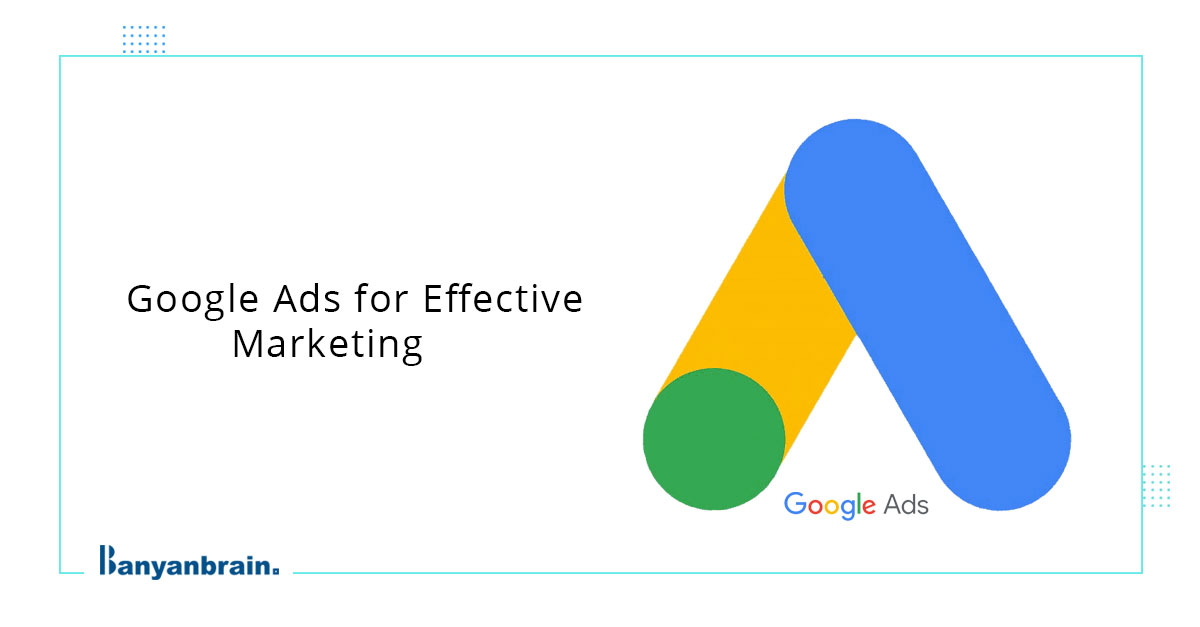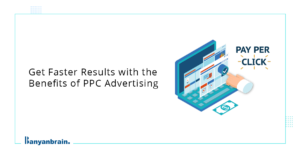Advertisers are choosing Google Ads for effective advertising as it can draw in diverse traffic from various parts of the world, generating new leads and driving conversion rates. Therefore, Google is the most popular global search engine and is used by millions daily. This makes it a prime site for businesses to run ads to raise brand awareness, build brand reputation and establish brand trust in the global market. Google ads are a part of pay-per-click advertising, an effective digital marketing strategy that helps businesses promote their brands. Let us learn more about Google ads and how it works.
What is Google Ads, and how does it work?
Google Ads, also known as Google AdWords, is a form of paid digital marketing strategy that is one of Google’s advertising systems used to promote businesses. It is a sub-branch of pay-per-click marketing that helps run paid ads that enable businesses to market their products and services to build brand awareness and increase brand reputation, lead generation and conversion rates. The PPC performance through advertising solutions can be improved by choosing the right performance marketing agency. Google extends its services to all partner sites and apps to ensure maximum exposure to the business running ad campaigns.
It works similarly to any other PPC ad. It begins by bidding on relevant keywords related to the brand, its products, services and values. The advertisers can bid whatever amount they want to invest based on different marketing goals. For example- While some marketers pay for every click on their ads, others pay for the impressions on the ads. The ads display certain offers or schemes to target viewer interests and grab the maximum number of clicks using target keywords.
What are the main benefits of advertising on Google Adwords?
This ad campaign is exceptionally beneficial when businesses try to reach their marketing goals.
- Faster than SEO- Google Ads is a type of PPC advertising and, therefore, works to reap almost similar benefits. It gives faster results as compared to search engine optimisation by increasing outreach. SEO is comparatively slower as it builds on algorithms to attract organic traffic, and it takes time to rank a website on search engines in all aspects. Therefore, Google ads are paid and appear for search queries with keywords similar to your ad campaign.
- Increase brand awareness- Advertisers use Google ads for effective advertising as they offer increased brand visibility when ads appear on the screen whenever users enter related search queries. By customising ad campaigns, your ads can rank on Google, which also helps provide authority to your website. Moreover, a brand’s recognition is directly proportional to the clicks on ads and conversion rates.
- Target specific audiences- Google shows ads to only those customers who search for related keywords and, therefore, helps target appropriate audiences instead of wasting clicks where conversion rates are minimal. You can customise your ads by specific location, languages and keywords to refine your audience list and improve conversions.
- Monitor ad campaigns- Keeping track of ad performance to maximise output is essential. The main task of advertisers begins after posting the ads. They can track and monitor analytics reports through Google AdSense, which helps report cost-per-click, impressions, number of clicks, demographic traffic, time-based traffic, etc. Advertisers can make data-driven decisions to change ad strategies if required and improve revenue.
- Maximise ROI– Google Ads have the flexibility to give results on both small and big-scale investments. However, the higher the bid, the higher your brand reach. You can set a daily budget for your ad campaigns with Google Adwords. Based on your goal, conversion or impressions, the ad campaign will terminate once the goal is met for the day.
What are campaigns in Google Ads?
Different ads clubbed together to fulfil the same objective in marketing for a brand is known as an ad campaign. The campaign entails a set of keywords, ads, and bids dedicated to performing a similar function, such as brand awareness or driving sales. All ads in the campaign share a similar budget, location, target and marketing strategy. For example – A set of ads is run by the advertiser to promote different products and services across the vast search results of the search engine. An AdWords campaign allows the host to target maximum, diverse, and relevant keywords in one go. Therefore, it becomes easier to customise and optimise Google ads for effective advertising.
What are the five different types of campaigns within Google Ads?
There are a variety of Google ads for effective advertising that offer maximum ROI and increase the chances of achieving the marketing objective.
- Display ads – A suitable match for websites and apps, display campaigns or ads are famous for their visualised ad campaigns in images, videos, and gifs. These marketing ads are incredibly beneficial in increasing user engagement through visual tactics that can help achieve the marketing objective. The ads can be static or animated to give its audience a more appealing and personalised experience.
- Shopping ads – These ad campaigns are created to offer information about products or services of a brand even before the potential customer clicks to end up on the landing page. As soon as users type a query, they can see persuasive ads for them to click and visit. These campaigns are product-specific and target customers’ interests by intriguing them and offering various sale prices. It is helpful to advertisers as they can push their products to customers who are motivated to make a purchase.
- Search ads – These appear as ad boxes above the organic results on the SERP when a user enters a relevant query. It is a prime example of pay-per-click, where the advertiser gets charged only when someone clicks on the search ads. It is a beneficial marketing strategy to drive traffic and sales or generate new leads. The ads are relevant to the products and services of the brand and can be customised to appear on the search engine.
- Video ads – Apps and websites partnered with Google search engines such as YouTube are prime sites for running video ad campaigns. It uses videos featuring a brand’s various products and services most creatively and engagingly. The time duration of video ads can be tailored between a few seconds to a minute. Moving images with a relevant script can push users to the website’s landing page.
- Maximise ROI– If your brand has an app for selling products and services, app ad campaigns are the most effective marketing method. Google properties such as Google Play Store, YouTube and the search engine are relevant platforms for displaying app ads. The purpose is to drive the download rate of the mobile app by promoting it and reaching diverse audiences.
What are the three critical components of Google Ads quality score?
The quality score of ad campaigns is essential as it diagnoses the quality of ads compared to other advertisers or competitors. Based on the relevance of keywords, Google measures the performance of the ads and its landing page to reflect a score somewhere between 1-10. A higher quality score symbolises a highly effective and optimised ad campaign and landing page. It also signifies that the ad is more relevant to your keywords than other advertiser’s. Google Ad’s quality score is meant to enhance the user experience and is not a key ad performance indicator. The three components of a quality score when measuring and recording it are-
- Click-through-rate- It signifies the number of times a user clicks on your ads when it flashes on their screen after searching for a similar query. It measures the potential of the ad and its capability to draw users to its landing page.
- Maximise ROI– Semantic indexing of Google Ads helps in ranking ads to search queries that do not use the exact keywords but are nearly the same as the main keyword. Therefore, ads must be administered to match user intent.
- Effectiveness of landing pages- The ads’ landing page must contain relevant information and CTA buttons promoting sales. Google diagnoses how helpful your landing page is for people who get redirected there.
How do I use Google Ads for marketing?
- Start by creating and setting up your Google ads account by visiting ads.google.com.
- After setting up, you get a prompt to move on to setting up a smart campaign by switching to expert mode. You can do it manually by customising your ad campaign.
- Google will then ask you to choose your marketing objective- clicks, conversions, and lead generation.
- Next, select a campaign type in Google ads- display, shopping, video, apps, and search ads. Based on your objective, Google suggests the most relevant campaigns.
- Visit Google Ads Analogy to enter your campaign name and select a suitable network- YouTube, search engine or other partner sites to run the campaign.
- Set a schedule for when you want your ads to be displayed. Not all hours of the day are equally effective to run campaigns, so Google facilitates advertisers by offering them time customisations. Remember the different time zones based on the locations where the ad will run.
- Select your target audience by setting a language and location where you want your ads to run.
- Enter your daily budget that you can spend on clicks made throughout the day. If the budget is too much or too little, you may not achieve the required results and suffer losses. To calculate your ideal PPC budget, divide the average of your CPC ( cost-per-click) or CPA (cost-per-action) by 30.4 (average number of days in a month).
- Next, select your bidding strategy that ranges from maximising clicks and conversions to increasing shares and impressions. The keyword bidding can be manual and automated.
- This is followed by filtering and entering the keywords that can be exact matches, phrase matches, or semantic matches to the products and services offered by the advertiser.
- Make your ad copy by adding at least 8-10 headlines and 3-4 descriptions. The headlines must be of varying lengths, and three out of all headlines must focus on a benefit, CTA, and feature instead of target keywords. You can pin vital headlines.
- Go ahead and supplement your ad copy with add extensions to improve your CTR. Add external links to your ad copy to offer extra information, such as call now, register yourself, etc. Ad extensions help in driving the users to take some action.
- Optimise your budget and target based on the device the ad campaigns get viewed on. For example, most users surf the web through mobile phones compared to tablets. Advertisers can reap extra benefits by settling for an extra budget for phones and less for tablets.
- You must ensure a well-designed and technically working landing page that appears in front of the users when they click on an ad.
- You are ready to post your ad and make it live on various Google-partnered platforms.
Here are a few steps to follow when using Google Ads for effective advertising and reaping the maximum benefits to reach and grow diversely.
Banyanbrain is a stellar digital marketing service company in Gurgaon that extends various marketing services, including PPC. Our team is skilled and well-equipped to run ad campaigns based on your marketing objectives.






![Read more about the article Everything about Google Remarketing [Retargeting Ads]](https://banyanbrain.com/wp-content/uploads/2024/08/Add-a-subheading-7-300x157.png)
